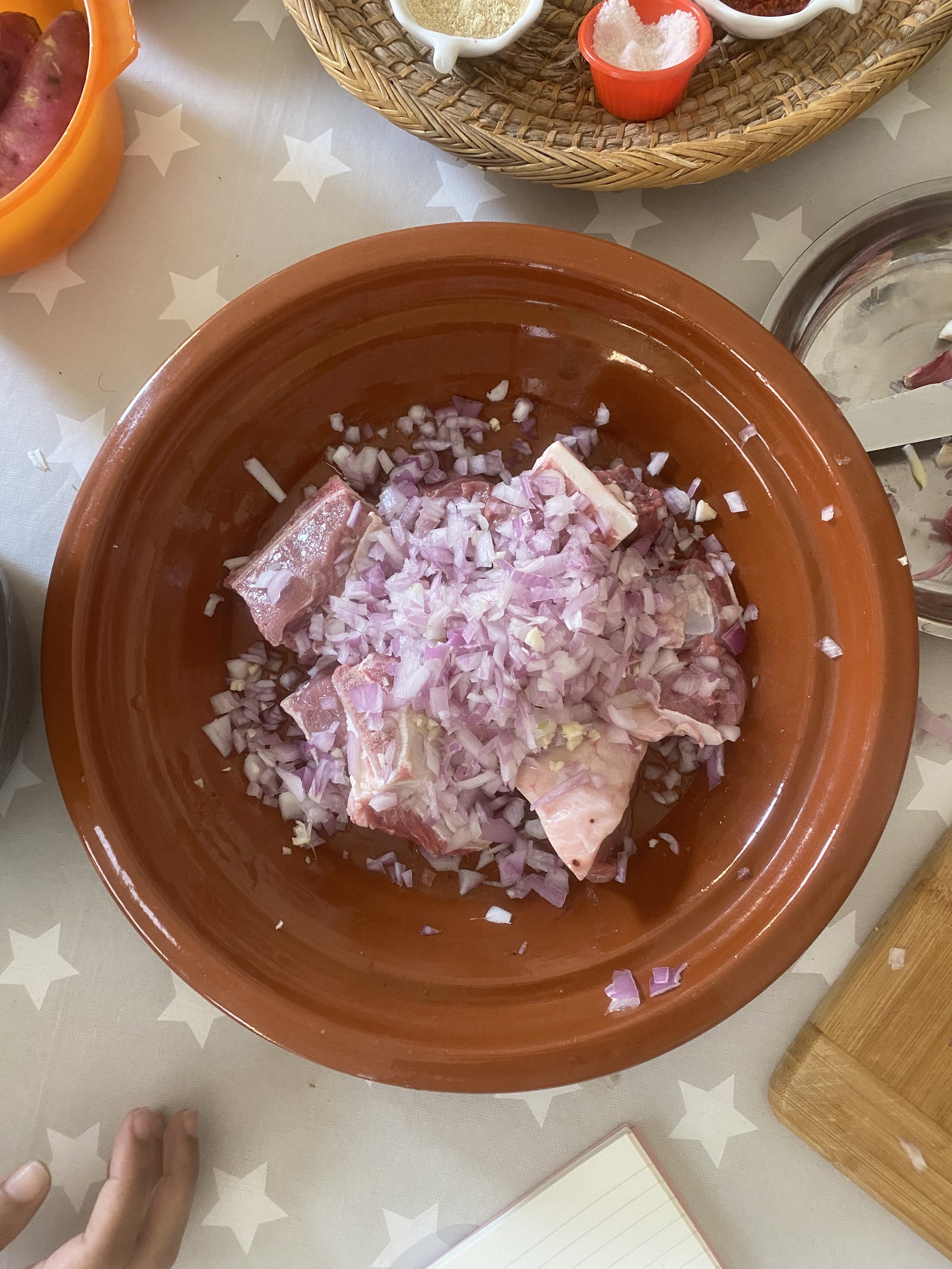Tagine of eight hands
Say that you’re visiting Morocco as a food traveller and ‘aaah tagine’ is often the reply. The call and response of geography and dish.
Restaurants tout their own version of a tagine.
Guide books say you must eat a tagine.
Online articles tell you the 10 best places for tagine.
So I’ve struggled to get my head around tagine, re-writing this article 3 times. The pressure of a dish so well known.
The problem is that the tagine is not just the recipe, but the dish it is cooked in too. The ceramic conical shaped lid tapering, a small hole sometimes to release steam. “The older the tagine, the better the taste” Kenza had said as we’d walked past them in the suq.
To my mind, then, there is no such thing as a tagine.
There are as many iterations as there are hands that prepare it.
Between us we have 8 hands - Amina, Kenza, Alex and me.
This is the story of our tagine, prepared in Amina’s Essaouira flat, with Kenza, her daughter, kindly helping translate.
I wash my hands in our flat, rinsing off the suq sweat. My tagine ablutions.
Upstairs, Amina has changed since we were in the suq. A green head scarf (her favourite colour) covers her hair, a grey apron with gingham pockets hangs loosely from her neck. The innards of our lunch are nearly placed across the kitchen table on top of a waxy grey tablecloth with white stars.
Amina’s prepared table
Onions peeled, artichokes undressed. Kenza sits podding peas.
I chuckle to myself. Amina has prepared both her kitchen and herself for the potential splashes of our lesson.
Spices heaped in little dishes. It is a roll call of the senses:
Garlic granules
Ginger
Turmeric
Cumin
Saffron
Mastic gum
Ras el hanout
Paprika
Spicy paprika
The meat is fresh, halal, “the most humane way of killing” Kenza says. The bone is important for the flavour. In my excitement, I don't even ask what meat it is, just hear “viande” and blindly accept. Beef maybe?
We dice red onions. These are the little knives I’ve met before. Everything is closer to the hand. We chase shards of onion around the chopping board.
Amina more deftly reduces our attempts to size. Small enough to “melt” with diced garlic and a little olive oil.
Low heat, lid on. No spices yet.
We don’t want them to burn, says Amina.
The viande and diced onions
I ask her who taught her tagine in the first place. “Her older sister” says Kenza, forever conscious of language, “my mother’s mum died when she was young.”
I hold that for a moment, hearing an answer before it has arrived, expecting to hear a lineage of mothers and mothers-in-law. The change in my expected narrative jolts, makes me hurt for Amina, for Kenza.
The image of flattened buildings in Gaza flashes before my eyes. Disruption.
Bad anthropology-ing.
This, then, is not just a tagine of eight hands, but many more. Of the hands that have taught and learnt and felt and shared.
Not just a tagine.
The onions are like butter, the meat browned. I pull out my phone to photo the spices arriving in the tagine, video capturing faster than my hands can write.
Turmeric (3 pinches), red pepper (1 pinch), spicy pepper (1 pinch), ginger (3 pinches), ras el hanout (1 pinch), salt (2 pinches), saffron (1 pinch, about 4 strands rubbed in her hands and then dropped on) and mastic gum (7 droplets).
The hot oil dances below the slowly melting meat and spices as the soak into the tagine. Mix.
The kitchen is cleaned down. Papery garlic skin, podded peas, errant puffs of spice cajoled into the dust pan and brush.
The vegetables are added. Trimmed artichoke heads, purple blushing sweet potato, peas are aimed into the middle of the tagine, cherry tomatoes balanced too. Amina pours a glass of water around the outside. Put onto high until it has come to the boil, then turn right down again.
Whilst all this has been going on, Amina has been leading us through three other recipes:
Shakshouka (roasted aubergine with tomatoes onion and garlic)
Zaalouk (flamed green peppers, onion, garlic and lots of cumin)
A potato gratin, with grated carrot and courgette topped with melted gruyère
Fish soup, the best I have ever tasted prepared the day before and then again week later when I asked to learn now to make it.
Fruit salad with rose water and cinnamon
Amina moves around her kitchen with such fluidity its hard to know where to look. Another language I am yet to learn. When I’m not looking, preserved lemon slices are added to the top, chopped parsley too.
The table is laid, 5 spoons as Maria, Kenza’s younger sister, has joined us.
Amina takes the top of the tagine. A moment which we weren’t expecting. So it goes back on, and as she heads back to the stove and we dive for our cameras, Kenza lifts the lid for the tagine paparazzi.
A terrible photo but I love the smile on Amina’s face
We eat with bread, Maria and Kenza sharing a piece as we’re one short. Scoop the tagine towards us. The veg is tangy with the preserved lemon that has steamed through it. Cherry tomatoes burst, their juices mixing with the bone marrow that has melted from the ‘viande.’ Each bready scoop is mellow with spices.
Eight hands, many more through time, in one tagine that tells the story of two visitors finding their way to Moroccan cuisine.




